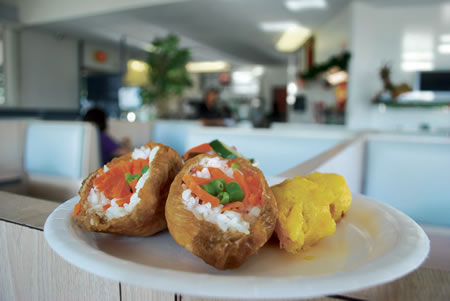Glamour To Simplicity In Island Dining
It’s back to business as usual for foodies after the extraordinary events of last weekend’s second Hawaii Food and Wine Fest. From $1,000-per-head dinners at Halekulani to classes and agricultural tours, the festival showcased Hawaii as a stunning example of a food-centric culture adjusting to the needs of a new world.
About six years ago a well-known food writer came to Hawaii to do a feature for a famous men’s magazine, and complained that “nothing was really happening” on the dining scene in Honolulu.
I do hope he’s invited next year to the Food and Wine Festival. For a small group of islands, we have plenty to get excited about. Even if it may mean eating your words …
The glamour of the weekend events served as a perfect contrast to the other side of our island food culture: the unpretentious kind that visiting chefs long to try. I had lunch at Kaimuki Grill Tuesday.
The tiny bar and grill is home to many who gather to enjoy great pupu and beers for lunch and dinner – especially during the football season. Though the food is simple, a garlic steak and Caesar salad were presented in a way that showed thought and attention to detail. It reminded me that people in the food industry take pride in their business – no matter how humble …
Every time I stop by Sekiya’s Restaurant and Deli I’m amazed by the buzz of conversation, the tables and booths filled at lunchtime, and the gen erations of families who come for okazu, oxtail soup or even an ice cream sundae.
The restaurant has been owned by the same family since 1935 – something of which they should be justly proud. Seventy-seven years in an industry that is unforgiving and demanding is no easy feat.
“What people like is that we make our sauces from scratch and use the same recipes we’ve always used,” says co-owner Joy Morihara. “They’re able to get the same kind of taste they’re used to.”
Schoolkids from neigh-boring Kaimuki High come in for deli treats and return as adults, bringing their own children for a taste that never seems to change. Devotees drive across island for a taste of Sekiya’s sweet cone sushi and homemade tsukemono, and regulars eat as frequently as three or four times a week.
In 1947, when the family moved from School Street to Kapahulu Avenue, plate lunches had yet to break the extravagant $1 mark and a bowl of steaming saimin cost just 30 cents. Prices are up a bit these days, but you can still get saimin for under $5 and a full-course yak-itori donburi (with miso soup, rice, tsukemono and tea) for under $10.
Truly, we live in one of the greatest places on earth when you’re eating dishes by Charles Phan, Ming Tsai, Celestino Drago and Marco Anzani one day, and dining on oxtail soup and nitsuke butterfish belly the next.
Happy eating!







